
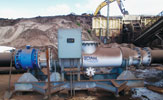
With major benefits to the mining, sewage treatment and power generation industries, OMSA has launched the DM3 non-nuclear, in-line, continuous density meter that calculates density by measuring direct mass over a known volume within a flow tube.
The DM3 was originally designed to replace obsolete technologies for the mining and dredging industries, and has proven to be safer and more cost effective than potentially hazardous nuclear techniques or inefficient auto-sampling methods. OMSA says it is offering this advanced technology to the local industry in response to growing customer demand.
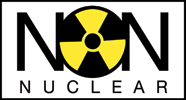
Principle of application
The DM3 offers a non-nuclear way to measure mining and dredging slurries and avoids the administrative and technical problems associated with nuclear devices. These include: compliance with Department of Health regulations; use of special safety equipment (Occupational Safety & Health Act); performing wipe tests; being part of National Nuclear Regulator and DMR surveys; employment of costly radiation officers; mitigation of health hazards as well as costly transportation and disposal issues.
DM3 interrogates mass per unit volume at 110 times per second, giving a response time of 45 milliseconds to any changes in the media density. In a mass flow system, this brings a new dimension of savings due to long term accuracy. The device interrogates a representative and continuous sample accounting for density variation across the diameter and metres in length of the measured media. It measures abrasive media easily due to its resilient natural rubber lined flow tube with customised options for high pressure and extreme temperature applications.
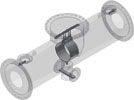
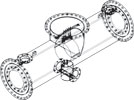
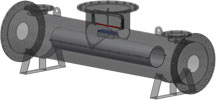
Applications
Developed by US based Sciam Worldwide, the meter has been utilised by a zircon slurry in Florida to calculate the percentage of dry solids, as well as by a phosphate mine for establishing the density of phosphate sludge. Accuracy has increased by more than 2,5%, giving substantial financial savings and a parallel increase in safety and efficiency.
The DM3 is insensitive to plant vibrations, noise, vacuum and temperature. Mineral beneficiation plants in southern Africa including coal, copper, diamonds, iron ore, gold platinum, uranium and zinc would find it suitable for tailings measurement as well as providing accurate control of plant efficiency and competent metal accounting.
For power generation plants, by-products such as fly ash slurry can be measured with greater confidence enabling energy savings with respect to pumping energy, water savings and pond size. By installing a DM3 density meter on the coal ash slurry pipeline, power plant operators have access to data for the density, wet or dry specific gravity and percentage dry solids of the slurry. When combined with the data received from a recommended volumetric flowmeter installed downstream from the density meter, the operators can then analyse the mass flow rate and totalised mass flow of slurry into the ponds. This way, an up to minute record can be kept of how much coal combustion waste is being produced as well as how much is on site in the ponds at any given time.
In wastewater treatment, better knowledge of input to sewage treatment plants and output sludge density can be used to improve operating efficiency particularly with respect to chemical dosing and biological oxygen demand. A DM3 unit is currently being used to measure biosolids removed from a wastewater treatment plant at a large city in the USA.
DM3 installations are used around the world to improve the efficiency of operations in many diverse industries such as pulp & paper, food & beverage and oil & gas production.
During the long-term life of its flow tube, the DM3 requires no periodic downtime for maintenance, except an occasional on-site calibration check. This is quickly achieved by running water through the unit without taking it out of the pipeline. No test weights are required, just a three second push of a button for a complete system diagnostic check. If acceptable this revalidates the original calibration, uniquely and directly to international weight standards
Each unit is custom designed and certified by CE, UL, NTEP and IECEE with directly NIST traceable measurements and in an environmentally friendly unit.
For more information contact Jan Grobler, OMSA, +27 (0)11 793 7421, [email protected], www.omsa.co.za

© Technews Publishing (Pty) Ltd | All Rights Reserved